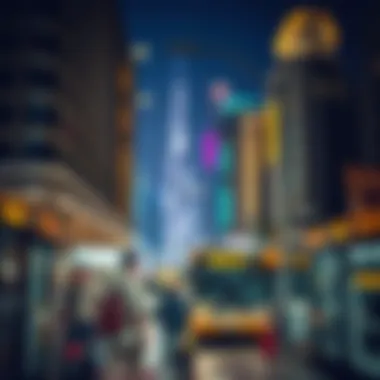RTA Timetable in Dubai: A Comprehensive Guide


Market Insights
Current Trends in Dubai Real Estate
Dubai’s real estate market has witnessed significant oscillations in the past few years, driven by both global economic influences and local developments. The demand for residential properties in areas like Dubai Marina and Downtown Dubai has surged, thanks to their proximity to essential services and vibrant cultural settings. Investors are increasingly considering the impact of public transport on property values, with the RTA timetable serving as a pivotal factor in their decision-making process.
With new projects, like the Dubai Creek Harbour and developments along the Emirates Road, buyers are keen to know how these properties connect to the RTA network. Understanding public transportation dynamics influences buying choices, making it much easier for home-seekers to envision their daily commutes or weekends out.
Investment Opportunities in Key Areas
Potential investors should look closely at properties near metro stations and bus routes. Areas like Jumeirah Village Circle (JVC) and Business Bay are gaining traction. These locales not only promise lifestyle benefits but also hint at upward shifts in property values, driven by proximity to reliable transport networks.
Consider these aspects when evaluating investment opportunities:
- Accessibility: Properties located near key transport lines often boast higher rental yields and resale value.
- Future Developments: Finding areas slated for new metro expansions or bus routes can make a property a goldmine in the long run.
- Market Conditions: Keeping an eye on the balance of supply and demand in real estate can identify emerging hotspots.
In summary, the interplay between the RTA schedule and property portfolios can either bolster or hinder an investment’s appeal.
Lifestyle Features
Luxury Living and Amenities
Luxury properties in Dubai, such as those in Palm Jumeirah and Arabian Ranches, present a blend of opulent living and accessibility. The RTA has developed exclusive services, like high-end bus routes that serve these upscale neighborhoods efficiently. The ease of getting around not only serves the needs of residents but appeals to visitors as well – enhancing the overall appeal of these neighborhoods.
Additionally, amenities like shopping malls, parks, and entertainment facilities are often clustered together with public transport nodes, crafting an active lifestyle. The RTA’s partnerships with ride-share services have further expanded options for those craving convenience.
Cultural Attractions and Experiences
Exploring the city becomes a breeze with the comprehensive RTA network. Cultural phenomena such as the Dubai Opera, Al Fahidi Historical Neighborhood, and the Dubai Mall are well-served by metro stations and bus routes. This eases travel for both tourists and residents, fostering an enriched community vibe.
Notably, public events and festivals often align with transport schedules, making it easy for everyone to partake in local culture. Organizers frequently coordinate transportation options for large events, ensuring smooth movement without chaos.
"Understanding the RTA timetable is more than just knowing when the bus arrives; it's a key to unlocking the vibrant life of Dubai."
Throughout this guide, it becomes clear that knowledge of the RTA's timetable not only shapes commuting but shapes living in Dubai. Whether you're a long-time resident or just dipping your toes into the market, recognizing the importance of public transport can greatly enhance your experience in this bustling city.
Closure
As Dubai continues to evolve, staying ahead of the curve in both investment decisions and lifestyle enhancements depends on understanding the intricate dance between real estate and transportation. Prospective buyers and investors are encouraged to leverage this guide to navigate the landscape smartly.
Prelims to the RTA Timetable
Navigating the bustling metropolis of Dubai requires an understanding of its public transport system, particularly the RTA timetable. The timing of different transport options can significantly influence daily commutes, real estate decisions, and overall lifestyle choices in this vibrant city. This section lays the groundwork for comprehending the RTA's timetable offering, aiming to illuminate its importance for residents, investors, and newcomers alike.
Overview of RTA
The Roads and Transport Authority (RTA) of Dubai is the governing body responsible for the city’s transport infrastructure and services. It’s like the backbone of Dubai’s connectivity, managing a diverse portfolio from buses and taxis to the expansive metro system. The RTA operates with a vision to create a safe and seamless transport environment, fostering economic growth and enhancing the quality of life in the city. Their well-structured timetable is essential, allowing travelers to plan their journeys wisely.
By delivering reliable transport options, the RTA plays a crucial role in supporting the city’s dynamic environment. Whether you are catching a bus to work, boarding a metro to a meeting, or hailing a taxi for a dinner reservation, aligning with the timetable can save time and reduce stress. The authority also emphasizes efficiency and customer satisfaction, continuously updating their timetables to meet the ever-evolving demands of the growing population.
Importance of Timetable in Daily Commute
The timetable is not just a collection of times; it represents the pulse of daily transport for thousands. It provides clarity and expectation, ensuring commuters are not left guessing when the next service is due. Understanding this schedule can lead to significant benefits:
- Efficiency: Commuters using the RTA timetable can streamline their logistics. They can plan their routes ahead, factoring in different modes of transportation to arrive at destinations promptly.
- Stress Reduction: With a clear timetable, the anxiety of waiting for an unarrived bus or a delayed train diminishes. This predictability fosters a more relaxed commuting experience, a boon to both Residents and workers alike in a city as busy as Dubai.
- Financial Savings: Efficient use of public transport, facilitated by the timetable, can lead to considerable savings. Instead of wasting money on taxi fares, commuters can make use of inexpensive bus or metro options while ensuring they reach their destinations on time.
- Encouragement of Public Transport Usage: When residents see that public transportation options are timely and reliable, they are more likely to opt for these services over personal vehicles, benefiting traffic flow and reducing congestion.
In essence, the RTA timetable is not merely a schedule; it is a pivotal element that influences nearly every aspect of daily life in Dubai.
"A timetable is the heartbeat of the public transport system, breathing time into the life of the city."


For anyone considering a move to Dubai or an investment here, understanding the intricacies of the RTA timetable provides valuable insights into how transportation dynamics work within the urban framework. With the city evolving rapidly, having a firm grasp of these schedules will aid in making informed decisions, whether it be for residential choices or business engagements.
Understanding RTA Classes of Transport
When we talk about the RTA in Dubai, it’s essential to get a grip on the different classes of transport available. This understanding will help you navigate the bustling avenues of Dubai more efficiently. The RTA's public transport classes are designed to cater to various needs, each playing a crucial role in the city’s transportation framework.
Buses
Buses in Dubai are much more than mere vehicles; they are a lifeline for many residents and visitors. The bus network is extensive, offering over 1,250 buses that serve various routes across the city. Each bus is air-conditioned, accommodating the sweltering heat typical of Dubai.
The benefits are plentiful: for one, buses are quite cost-effective. A single fare can take you across most areas of the city, making it a budget-friendly option for both short trips and day-long adventures. Moreover, certain bus stops connect seamlessly with the Metro stations allowing passengers to shift with ease.
A note to consider, however, is the scheduling. Depending on the time of day, bus frequency might vary, especially during peak hours. Understanding the specific bus timings can save you from extended wait times.
Metro
The Dubai Metro is an engineering marvel and the backbone of public transportation in the city. With two main lines, the Red and Green, it connects key areas, including the Dubai Mall, Dubai Marina, and the Expo 2020 site. What makes the Metro particularly appealing is its punctuality and reliability. Trains run every few minutes, so you won't be left hanging for long.
The stations themselves are clean, modern, and often equipped with various amenities. For example, at many Metro stations, you’ll find facilities like shops and food outlets, making it convenient to grab a meal or a drink on the go.
Nevertheless, keep in mind that peak hours can see packed trains. If you're looking for a comfortable ride, consider outside rush times.
Water Transport
Dubai's location along the coast makes water transport not just an aesthetic choice but a practical one as well. With options such as abra rides, which are traditional wooden boats, you can cross Dubai Creek quickly while enjoying the stunning views. Water taxis are another modern alternative, offering a more luxurious experience.
The benefit of this mode of transport is twofold. First, it allows you to avoid the bustling roads, especially during traffic jams. Second, it adds an enjoyable twist to your journey, transforming a simple commute into a mini-cruise on the water. It's an aspect of travel that often gets overlooked but is incredibly enriching. However, service frequency can vary, particularly in adverse weather conditions.
Taxis and Ride-Sharing
Taxis are ubiquitous in Dubai, easily hailed at the street or booked through mobile apps. They are comfortable and comparatively reasonably priced. What stands out about taxis in Dubai is the availability of options, including standard taxis, luxury taxis, and even dedicated female drivers for female passengers.
As for ride-sharing services like Uber and Careem, they fit seamlessly into the transport ecosystem, providing flexibility and often a quicker means of transport. Just a quick tap on your phone can get you a ride in minutes. Be mindful, though, that surge pricing during peak hours can make this option less economical.
All these modes of transport contribute to a well-rounded public transport system that reflects Dubai's vibrant lifestyle. Understanding these options and their nuances not only enriches your commuting experience but can also inform your real estate decisions by highlighting accessible neighborhoods.
Being informed about the RTA classes of transport can significantly enhance your overall Dubai experience, whether living or visiting.
Components of the RTA Timetable
Understanding the components of the RTA timetable serves as a vital piece for any individual navigating Dubai’s public transport landscape. The minute details—such as service hours, frequency of the services, and special schedules during holidays—compose a network that fulfills the diverse needs of commuters across the city. Each aspect holds significance, not only for the casual user but also for residents, investors, and expatriates whose movements hinge on the reliability of this system.
Daily Service Hours
The daily service hours of Dubai’s public transport take into account the hustle and bustle of its vibrant lifestyle. Generally, the RTA transport services kick off bright and early, designed to accommodate both morning commuters rushing to work and late-night travelers concluding their day. For example, the metro typically opens around 5:30 AM on weekdays, providing ample opportunity for early birds to kickstart their day.
Weekends often see a different schedule. Sometimes, services might begin later, aligning with a more leisurely pace. This variance allows residents to plan their activities accordingly, ensuring smooth logistics whether it’s for business meetings, school runs, or weekend outings. Knowing these operating hours is indispensable for making well-informed decisions about time management, especially when considering potential property investments close to these transport arteries.
Frequency of Services
The frequency of services plays a pivotal role in maintaining a steady flow of people, minimizing wait times and frustrations. Buses, metro, and water taxis must run with such regularity that commuters can rely on them as if they are clockwork. Metro trains in Dubai run approximately every 5 to 7 minutes during peak hours. This reliability not only saves time but also ensures that the city remains accessible for all.
On the bus front, the RTA has rolled out a comprehensive plan that covers both main routes and less-traveled paths. Commuters can expect buses to appear every 10 to 15 minutes during busy periods. Such efficiency invites a larger crowd to forsake personal vehicles, ultimately reducing congestion—a critical aspect for urban planners and developers who eye sustainable projects.
Holiday and Weekend Schedule
When it comes to public transport, holiday schedules often present a mixed bag of opportunities. The RTA recognizes that during major holidays like Eid or Dussehra, the public enjoys longer leisure time, leading to increased demand for transport services. Hence, special arrangements are made. This may include extended hours and increased frequencies.
Weekends also modify regular operation times, embracing a more relaxed approach that still prioritizes the needs of travelers. These tailored services highlight the adaptability of the RTA in meeting user needs and enhance the overall commuting experience.
It is essential for both homeowners and investors to grasp these particulars; the way public transport accommodates holiday schedules can affect property desirability. Homes nestled near well-serviced routes often enjoy a boost during festive periods, making them more appealing to a broad array of potential tenants.


Understanding the components of the RTA timetable is not just about catching a bus; it’s about comprehending the entire ecosystem of urban mobility.
Utilizing the RTA Timetable Effectively
Understanding how to use the RTA timetable is of utmost importance for both residents and visitors in Dubai. An effective grasp of the timetable can significantly enhance one’s experience in navigating the urban landscape, making daily commutes feel less like a chore and more of a seamless journey. This section delves into specific methods on how to access timetable information, utilize mobile applications for real-time updates, and plan routes effectively, ensuring travelers can optimize their time and avoid unnecessary delays.
Accessing Timetable Information
Accessing the RTA timetable information is a straightforward process but hinges on knowing the right platforms. The RTA offers multiple ways to view their schedule, catering to different preferences. Travel enthusiasts can access it through:
- RTA Website: The official Dubai RTA website (rta.ae) provides detailed information on all modes of public transport, including buses and metro services.
- Station Displays: Clear and concise digital displays at stations present real-time information about upcoming departures and service status, crucial for on-the-spot decision-making.
- Printed Timetables: Though a bit old-school, printed schedules are available at various transport hubs, beneficial for those who prefer tangible forms of information.
Having access to these various avenues means you can quickly tap into the latest information, whether at home or on the go, ultimately making your travel smoother and less stressful.
Mobile Applications for Real-Time Updates
In today’s tech-driven world, the use of mobile applications has revolutionized how we interact with transport services. The RTA’s dedicated apps, such as ‘RTA Dubai,’ provide instant updates on:
- Live Vehicle Tracking: You can see exactly where your bus or metro is on the route, which helps in managing time better.
- Alerts on Service Changes: Users receive notifications regarding delays or service alterations, helping you adjust your plans accordingly.
- Integrated Payment Systems: Many apps allow you to pay for rides with a few taps, removing the hassle of cash or cards while you are on the move.
Utilizing these apps can turn a major inconvenience into a simple task, allowing for a greater focus on your daily activities.
Planning Your Route with the Timetable
Effective route planning is essential in a bustling city like Dubai, where traffic can be unpredictable. Here are some key strategies to consider:
- Study the Frequency of Services: The RTA timetable indicates how often transport services run, which is invaluable for efficiently scheduling your day. Knowing when to catch the next bus or train prevents unnecessary waiting.
- Use Multi-Modal Combinations: Often, a combination of different transport types can save both time and money. For example, taking a metro to a nearby station and then a bus can cut down travel time, especially during peak hours.
- Identify Nearby Stops: Make sure to locate stops that are conveniently close to your starting point and destination to enhance your overall experience.
By diving into each aspect of route planning, commuters can better manage their time, leading to enhanced productivity and fewer frustrations.
"An informed traveler is a happy traveler; knowing your way around Dubai's transport can take you places beyond just geography."
Equipping oneself with the tools and knowledge to effectively use the RTA timetable can transform public transport from a daunting task into a reliable component of daily life in Dubai.
Impact of RTA Timetable on Real Estate Decisions
The interplay between the RTA timetable and real estate decisions in Dubai is a crucial aspect that cannot be ignored. Understanding how public transport systems functionally enhance accessibility and convenience can heavily influence where to live or invest in property. The RTA timetable doesn’t just dictate when the buses or metro trains will arrive; it shapes the very fabric of residential and commercial zoning across the emirate.
Neighborhood Accessibility
When evaluating neighborhoods, accessibility is often at the forefront of potential buyers' and renters' minds. Areas well-served by the RTA public transport system tend to garner more interest given the ease of getting around. For instance, a residential area such as Dubai Marina is known for its proximity to metro stations and bus routes. Buyers are more likely to flock to areas with a robust transport network, as it offers them the flexibility of commuting without the necessity of owning a car.
The RTA timetable offers a reliable measure for exploring nearby amenities, such as shopping centers, schools, and medical facilities, further enhancing a neighborhood's attractiveness. An easy bus ride or metro trip to key local institutions can make or break property appeal.
“Accessibility has become a primary real estate determinant, where residents seek neighborhoods with seamless transport connections.”
Consider the recent uptick in popularity for areas like Al Qusais, where improved bus schedules mean faster links to major commercial hubs. When discussing proximity, it’s not just about distance; it’s about how quickly one can reach their destination.
Influence on Property Values
It's no secret that property values fluctuate based on location, and public transport accessibility is one of the major driving forces behind this phenomenon. When an area shows promise in terms of transport connectivity — such as a new metro line being introduced — anticipation often leads to a spike in property values. Investors keenly watch the RTA announcements, deliberating on investments that could yield significant returns, as they foresee the long-term boost in property demand.
Conversely, if the services suffer from delays or erratic schedules, it can diminish a neighborhood’s appeal, leading to a downturn in property values. Those residing in less accessible areas may struggle to attract buyers or tenants. Ultimately, consistent and reliable services outline the value proposition of any given area.
Public Transport and Lifestyle Choices
In the current urban climate, public transport systems dictate how people choose to live, work, and spend their leisure time. The RTA timetable plays an understated but pivotal role in shaping lifestyle choices in Dubai. The ease of hopping onto a well-timed metro or bus can greatly influence daily routines and work-life balance. Many young professionals prefer areas that allow them to work closer to a metro station or bus stop, reinforcing a lifestyle centered around convenience.
Investors also consider these lifestyle shifts as they gauge market demand. Areas with vibrant public transport options often attract younger demographics who prioritize mobility and sustainability. Those choosing to forego car ownership are frequently drawn to neighborhoods offering efficient transport routes, tailoring their lifestyle choices around the accessibility provided by the RTA.
Through examining how public transport informs real estate decisions, it becomes clear that the RTA timetable is more than just scheduling; it’s an integral player in the ongoing dialogue about where to live and work in Dubai.


RTA Initiatives for Improvement
When discussing the Public Transport sector in Dubai, RTA initiatives for improvement serve as a cornerstone of effective development and operational efficiency. This not only includes the enhancement of existing services but also the implementation of innovative strategies aimed at elevating the overall commuter experience. Given the rapid urbanization of Dubai, such initiatives play a crucial role in catering to the ever-increasing population and their transportation needs.
Future Expansion Plans
Dubai is on the brink of an expansive horizon in terms of public transport. The RTA has laid out detailed future expansion plans to further integrate various transport modes connecting neighborhoods seamlessly. One notable initiative was the announcement to extend the metro lines to reach areas like Dubai Investment Park and the Expo 2020 site, thus improving accessibility for many residents. Not just limited to metro expansion, the RTA is also looking at increasing the coverage of bus routes and introducing new water transport lines.
Moreover, as cities globe-trot through technological advancements, the RTA is adopting smart mobility solutions. This might include automated trams or even electric buses. Such projects not only aim to provide extensive coverage but also focus on ensuring that the infrastructure keeps pace with sustainable transport modes.
"The future of public transport in Dubai is about mobility as a service, where flexibility and technology converge to create a more user-friendly commuting experience."
Sustainability and Public Transport
Sustainability is at the heart of RTA's initiatives as Dubai strides towards becoming a global leader in green transport. The RTA is actively working to decrease carbon emissions and enhance the ecological footprint through various projects. Initiatives include the introduction of electric buses and energy-efficient metro systems.
Additionally, promoting public transport use is a vital cog in the sustainability wheel. Encouraging residents to switch from private vehicles to public transport can help alleviate traffic congestion and improve air quality. The RTA has implemented awareness campaigns aimed at highlighting the benefits of public transport, capturing the interest of both locals and expatriates alike.
Investors and property buyers interested in locations near public transport nodes should pay close attention to these sustainability efforts. Properties with quick access to public transport facilities are likely to maintain a higher value as sustainability becomes increasingly integral to urban living.
In summary, RTA’s future expansion plans combined with a strong focus on sustainability are pivotal in sculpting an efficient, eco-friendly public transport system. Both initiatives not only promise improved functionality but also essential support to lifestyle choices and the broader community in Dubai.
Challenges with the RTA Timetable
Understanding the challenges surrounding the RTA timetable is crucial for anyone navigating public transport in Dubai, especially for those who are new to the city or considering relocation. These challenges can significantly impact daily commutes, travel planning, and overall satisfaction with the transportation system. It is essential to address specific elements like common complaints, timeliness issues, and other concerns that might arise during usage.
Common Complaints and Concerns
Public transport systems are never without their issues. For Dubai's RTA timetable, passengers frequently voice a few common complaints. Here’s a closer look:
- Infrequent Service: Many users express dissatisfaction with the frequency of certain bus or metro lines, particularly during off-peak hours. When wait times stretch longer than anticipated, it can throw a wrench into tight schedules.
- Communication Gaps: Sometimes, there is a lack of real-time updates on delays or service changes. This may leave commuters feeling lost and frustrated, especially if they’re unfamiliar with alternative routes.
- Accessibility Issues: While Dubai has made strides in making transport accessible to all, some users with disabilities report difficulties in navigating certain services. This has raised concerns about compliance with accessibility standards.
- Peak Hour Congestion: Commuting during rush hour can feel like a game of sardines, with packed buses and metros leaving little room to breathe. This not only affects comfort but can also lead to delays.
These complaints can influence how people view the system and even discourage some from using public transport altogether. As such, understanding these challenges is critical for both users and the RTA to foster improvements.
Addressing Timeliness Issues
Timeliness is the heart and soul of any public transport system. When it comes to the RTA timetable, ensuring services run as scheduled can make a world of difference for busy commuters. Addressing timeliness can entail several strategies:
- Investing in Technology: With advancements in GPS and mobile apps, keeping users informed with real-time data about bus and metro arrivals can significantly alleviate concerns related to delays. Updates sent directly to smartphones might save travelers from unnecessary waiting.
- Regular Maintenance Checks: Vehicles should undergo routine checks to ensure they're in optimal condition. By investing in the maintenance of vehicles and infrastructure, the RTA can help reduce breakdowns that lead to service interruptions.
- User Feedback Channels: Actively listening to commuter feedback can provide valuable insights. Setting up platforms where users can report issues, suggest improvements, or fill out surveys might help the RTA understand where problems persist.
- Pilot Programs: Implementing pilot projects in specific regions can test new schedules or technologies, allowing the RTA to refine their approach before a citywide rollout.
Improving timeliness is not a one-off task; it requires continuous efforts and adaptations based on commuter behavior and usage patterns. As these challenges are systematically addressed, the experience for both expatriates and locals could improve significantly.
Closure on RTA Timetable Awareness
Understanding the RTA timetable is vital for multiple aspects of life in Dubai. The RTA (Roads and Transport Authority) timetable harmonizes the bustling city's transport system, making it easier for residents, investors, and tourists to navigate the landscape. Knowing how to efficiently use this timetable can greatly enhance one’s mobility and daily routine.
Summarizing Key Insights
In summary, some critical insights surrounding the RTA timetable include:
- Operational Efficiency: The timetable reflects the current operational hours, allowing users to plan their journeys with precision. Individuals can avoid unnecessary waiting or confusion.
- Transportation Options: Various transport classes, like buses, metro, and water taxis, are all coordinated under this timetable, indicating the flexibility in choices available to commuters.
- Seasonal Changes: During holidays and weekends, alterations in service frequency are available, helping residents and visitors to adjust their planning accordingly.
"A well-structured timetable is not just about time; it’s about structure and convenience for the whole city."
These insights not only help in presenting factual information but also paint a vivid picture of the interconnectedness of public transport and daily life in Dubai.
Encouraging Engagement with Public Transport
Encouraging the use of public transport is not just about promoting eco-friendly practices; it also involves enhancing the quality of life for the populace. Here are several reasons why engaging with public transport should be a priority:
- Cost-Effectiveness: For many, relying on public transport can significantly reduce travel expenses compared to owning a personal vehicle. Bypassing fuel costs, parking fees, and vehicle maintenance adds up to substantial savings over time.
- Community Connectivity: Public transport offers a way to connect with diverse communities. Engaging with fellow passengers fosters a sense of shared experience, promoting social cohesion.
- Environmental Benefits: Utilizing public transport reduces carbon footprints, thus sustaining Dubai’s commitment to promoting a greener environment.
To wrap things up, a comprehensive understanding of the RTA timetable is crucial for navigating the public transport landscape in Dubai. This knowledge not only benefits individual commuters but also has broader impacts on community engagement and environmental sustainability.
For further information, individuals might consider visiting the official RTA website at rta.ae or checking social platforms like Reddit for community experiences and discussions.
Encouraging exploration through public transport is a step towards a more integrated and accessible city.















